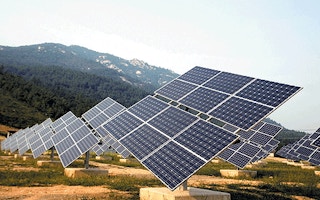There has been quite an abundance of attention placed lately on solar power as more and more residents and businesses begin to realise the efficiency of photovoltaic energy. Like a hip trend, solar arrays have begun to sweep nations as governments place mandates and goals to reach a certain amount of renewable energy creation by 2020.
An area that has been on the minds of many is the Korean peninsula. Without having a substantial amount of resources of its own, Korea could greatly benefit from the power generated by the sun.
It only took the single instance of a nuclear power plant going critical to entice Japan to invest in solar power. Two years after the Fukushima Daiichi incident, Japan is planning on building $20 billion worth of solar arrays by the end of 2013. If the Korean nations could follow suit, it would go a long way in preventing such a disaster on the mainland.
- Radiation Poisoning - Solar arrays won’t irradiate the populace if an unforeseen circumstance causes severe damage to the facility. Men wearing hazmat suits will not have to attempt to clean up a radioactive by-product that has potential to kill millions from mere exposure. All that is required from an array to function properly is the natural element from the sun that has been delivered to this planet for 4.6 billion years. If it were to go critical, the entire solar system could be annihilated.
- Skeptics - Many local energy companies and anti-global warming groups are calling renewable energy development premature and inefficient in terms of cost. As some of these companies are unable to afford implementing such plans of solar development, they are hesitant to embrace the idea of replacing resource-consuming power plants with solar generation. However, the monetary savings over time could be far worth the investment as less resources are needed to produce energy such as coal and oil. The affect radiation has on human life should be more than enough reason to look towards a cleaner way of developing power. As the cost to implement solar power has been continuing to drop, it seems more like these groups are holding firm to data collected about solar power from the early 2000s. If they sit back and wait for residents to develop their own means of power generation, these power plants could face extinction.
- Piecemeal - Solar power arrays can be installed a piece at a time. This means that the cost of an entire gigawatt of power doesn’t need to be addressed immediately. Many smaller cooperative power companies have been building 20-megawatt photovoltaic systems as money permits. Eventually, the solar arrays will replace all of the power generated from these power plants. In the meantime, that single 20-megawatt array can quell a great deal of the power strains on a grid including reduction of brown-outs. It seems that many of these power companies don’t realise just how effective and cost-efficient one development at a time can be.
- It Doesn’t Take Much - For a large family home in the center of the United States, a system that generates 5.5 kilowatts of power can deliver 100 per cent of the needs for that home while putting additional power back into the grid. These arrays could cost $80,000 or more depending on the installer and the locale of the array. That single 5.5-kilowatt system is all that is needed to help stave off brown-outs in that area. Even developing 100-kilowatt systems could relieve the needs of nearly 20 like-sized residential homes.
- Continuous Costs of Power - There are many aspects to producing power when using resource-burning methods that many don’t account for. The fuel that is consumed in order to transport the coal and/or oil to the power plant, the insurance coal-mining companies have to place on the workers, and the increased payroll in the form of hazard pay to miners are just a few instances that could go into traditional methods of generating power. In effect, there is more money as a whole put towards maintaining a coal-fired power plant than there is developing a solar array. In addition, the costs for coal will continue to burn through the pockets of those companies while a solar array only needs to be built once. Of course, there are bound to be maintenance costs on an array, but it can operate without continued cash flow for a great deal of time without additional costs.
Chernobyl and the Fukushima Daiichi failures could have been prevented if the human element would have been paying closer attention to the surrounding environment. Out of the many nuclear power plants around the globe, these are just two instances that stand out due to the sheer nature of the cataclysms. These two situations were dangerous enough to the world around them. However, the failure of a single renewable energy method has yet to cause such destruction.
Liz Nelson is a writer for Whitefence.com and green living enthusiast from Houston, Texas.

















